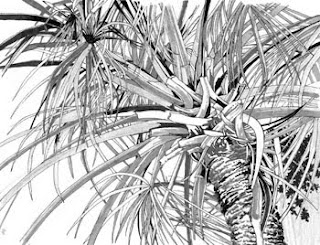 The masking has dried and here I am applying another wash. First I wet the paper with clean water. It's important to allow the water to soak in a little. This helps the pigments to flow nicely yet stay close to where you want them. I use three primary colors for the most part - blue, red, yellow.
The masking has dried and here I am applying another wash. First I wet the paper with clean water. It's important to allow the water to soak in a little. This helps the pigments to flow nicely yet stay close to where you want them. I use three primary colors for the most part - blue, red, yellow.When I apply the colors I just drop them into the areas where they would seem most appropriate. I don't brush them into each other, but lay them next to each other instead. Then I tip the paper to allow the colors to flow and blend.
 When you work wet-in-wet, remember that you can apply the colors quite a bit more dark than you think. Because the paper is already diluted, the colors will dry quite a bit lighter than they appear when they are applied. Experimenting with this helps.
When you work wet-in-wet, remember that you can apply the colors quite a bit more dark than you think. Because the paper is already diluted, the colors will dry quite a bit lighter than they appear when they are applied. Experimenting with this helps.More to come soon...











